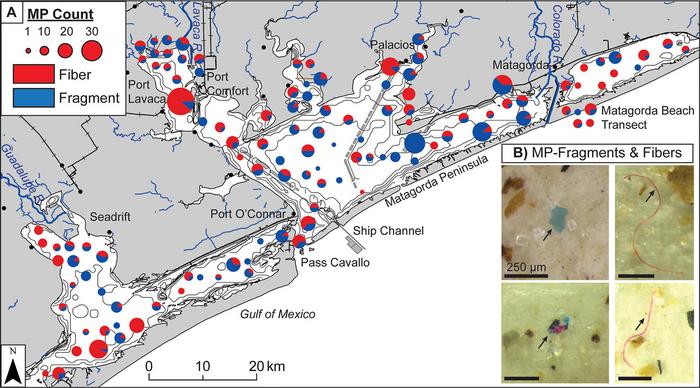Along the central Texas coastline, a region often spotlighted for its striking presence of plastic debris—including unusual items as wave-worn baby dolls—scientists from The University of Texas at Austin have embarked on an unprecedented study investigating the distribution and concentration of microplastics in bay sediments. Focusing on the Matagorda Bay system and its adjoining inlets, the research team uncovered surprisingly low levels of these pervasive environmental pollutants, a finding that challenges prevailing assumptions about microplastic accumulation in sheltered coastal environments.
The comprehensive survey involved collecting 122 sediment samples spanning Matagorda Bay, East Matagorda Bay, and San Antonio Bay. Using meticulous laboratory techniques that minimized contamination—including the use of natural fiber clothing, foil-lined sample containers, and custom-blown glass filtration apparatus—the researchers painstakingly isolated microplastic fibers and fragments from sediment particles. Their analysis revealed that sediment samples contained microplastic concentrations ranging from mere tens to hundreds of particles per kilogram, amounts that are dramatically lower than reported for other comparable bays worldwide.
This unexpected paucity of microplastics in the sediments suggests a dynamic coastal system where these particles resist long-term deposition. Instead of accumulating in the bay’s sediments, microplastics appear to be continuously transported and flushed out into the greater Gulf of Mexico. This finding significantly revises prior expectations about sedimentary microplastic sinks in shallow, wind-affected coastal environments and signals potential downstream ecological risks on larger scales.
Understanding the fate of microplastics transported out of Matagorda Bay is critically important because once released into the open Gulf waters, these tiny particles serve as vectors for chemical pollutants. Their surface properties enable them to adsorb various hydrophobic contaminants, which then bioaccumulate through food webs, affecting migratory seabirds, marine organisms, and potentially humans. Such ecological and health risks underscore why the dispersal mechanisms and final deposition zones of microplastics remain urgent research frontiers.
Central to explaining why Matagorda Bay sediments do not retain microplastics is the bay’s unique geomorphology and hydrodynamics. The area features shallow waters rarely exceeding 13 feet, combined with frequent high-energy disturbances from sustained winds and episodic hurricanes. This constant physical reworking of sediments inhibits particle settling and promotes resuspension, fostering continuous microplastic export. Additionally, the low density of most plastic types contributes to their enhanced mobility under these environmental forces.
Contrary to typical sediment transport dynamics, the study found no statistically significant correlations between microplastic concentrations and traditional sediment characteristics such as grain size distribution, organic matter content, water depth, or proximity to shorelines. This anomalous behavior reflects the unique physicochemical properties of microplastics compared to mineral sediments and highlights the need for integrating plastic pollution models with sedimentological frameworks.
The investigation is set within the emerging discipline of environmental sedimentology, which applies sediment transport theories to trace microplastics as particulate pollutants. By treating these anthropogenic fragments as analogous to natural sediment grains, geoscientists aim to predict their sources, transportation pathways, and depositional environments. This approach enables a more holistic understanding of microplastic dynamics in aquatic systems and opens avenues for improved monitoring strategies.
Notably, the research aligns with concerns stemming from local industry. Matagorda Bay hosts a plastics manufacturing facility producing nurdles—small plastic pellets serving as feedstock in global plastic production. Despite this, the most pronounced microplastic concentrations manifested closer to inland sampling sites, while more distal locations showed considerable dispersion. This spatial pattern suggests complex transport mechanisms that override simplistic source-to-sediment deposit assumptions.
Further complicating the microplastic landscape is the staggering volume of anthropogenic fibers shed into the environment. For instance, a single microfiber fleece jacket can release millions of fibers with each wash cycle. These fibers, prevalent in household effluents, ultimately enter waterways and contribute to widespread environmental contamination. The reality of such continuous inputs emphasizes the resilience and persistence of plastic pollutants in aquatic ecosystems.
The study holds broader significance as the scientific community grapples with methodological challenges. No universally standardized protocol yet exists for microplastic sampling and analysis, which hampers global comparison and consensus-building efforts. This research, by providing rigorously collected baseline data for a major Texas coastal system, contributes an invaluable reference point and encourages uniformity in future investigations.
Experts in the field, including Jace Tunnell of the Nurdle Patrol citizen science initiative and Texas A&M University-Corpus Christi, hail the study as a crucial advancement. They highlight that only through systematic documentation and heightened awareness of microplastic prevalence can meaningful remediation strategies be formulated. The integration of rigorous geoscience methodologies with pollution monitoring marks a vital step toward confronting pervasive global plastic pollution.
The research, supported by the Matagorda Mitigation Trust and the Jackson School of Geosciences, also embraces a forward-looking approach. Lead author William Bailey is currently developing predictive models to map potential trajectories of microplastics originating from Matagorda Bay. Such modeling endeavors could illuminate zones of particle accumulation and inform conservation planning, ultimately fostering targeted environmental management solutions.
In summation, this landmark study not only challenges assumptions about sedimentary retention of microplastics in shallow bay systems but also illustrates the interconnectedness of local pollution sources, coastal hydrodynamics, and broader marine pollution pathways. It underscores the urgent need for interdisciplinary strategies capable of tracking and mitigating the global microplastic crisis, bridging geosciences with environmental chemistry, ecology, and public health.
—
Subject of Research: Microplastics distribution and transport in coastal bay sediments
Article Title: Microplastics in Bays along the Central Texas Coast
News Publication Date: 5-Mar-2025
Web References: http://dx.doi.org/10.1021/acs.est.4c12622
References: Bailey et al. Environmental Science & Technology 2025, 59(10), 5249-5260.
Image Credits: Bailey et al./ Environmental Science & Technology 2025
Keywords
Environmental sciences, Plastics, Pollution, Pollutants, Water pollution, Chemistry, Earth sciences, Geology, Sedimentology, Sedimentation




